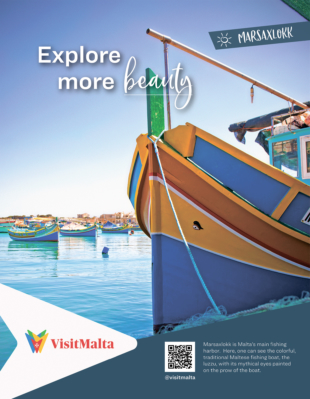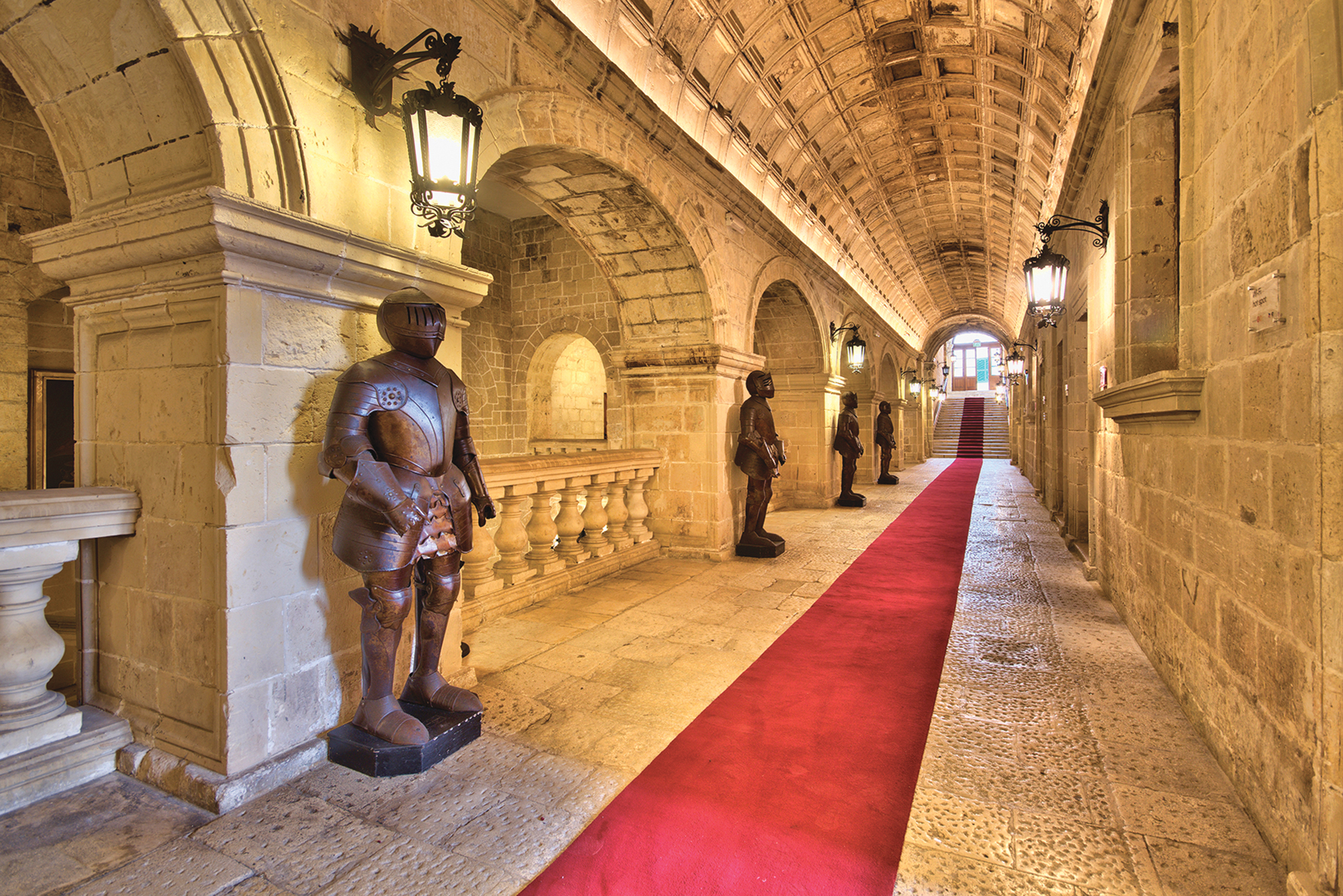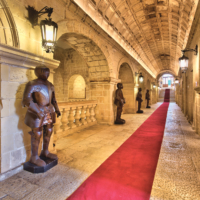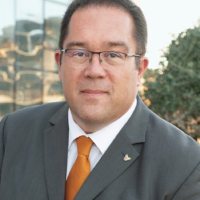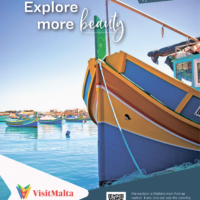While many countries around the world have struggled to hit prepandemic tourism figures, Malta has bounced back in style as a record number of inbound tourists visited the Mediterranean nation in 2023. More than 3 million people visited the island last year, exceeding the 2019 figure by an impressive 8.3%. The total tourist expenditure was also 32.7% higher than in 2022.
One of the key factors in Malta’s success was the effort carried out by the Malta Tourism Authority throughout the COVID-19 pandemic. While many countries discontinued operations and chose to cut back on advertising, the Malta Tourism Authority took a very different approach.
“The significant results in the tourism industry are testament to our unwavering belief in its potential. Throughout 2020 and 2021 we invested in industry-wide training programs, ranging from short courses for front-line staff to advanced degrees for management,” Carlo Micallef, CEO of the Malta Tourism Authority, explained. “This proactive approach ensured that when tourism rebounded, Malta was poised to deliver exceptional experiences. Throughout this period, our marketing team maintained robust communication channels with stakeholders worldwide, reinforcing Malta’s appeal to tour operators, travel agents and the public.

“Our commitment to continuous improvement and steadfast support for the industry never wavered, ultimately leading to the successful outcomes we celebrate today. We strived to showcase Malta’s unique offerings during the pandemic downtime, utilizing webinars and shipments of local products to engage potential visitors.
“With minimal competition in the media, we seized the opportunity to highlight Malta’s distinct attractions and preparedness for postpandemic tourism. This included niche market development, such as promoting our gastronomy, history and active tourism. We also invested in diving facilities, culinary experiences and attracting Michelin-starred chefs.”
This strategic approach was extremely successful. Once travel restrictions around the world began to be lifted, Malta immediately experienced a resurgence in tourism. Aiming to attract 1.8 million visitors in 2022, the country welcomed 2.3 million tourists. The tourism authority then built on this momentum by launching numerous advertising campaigns that emphasized the nation’s myriad offerings in gastronomy, history and cultural experiences.

“In 2023, we experienced significant growth from various markets, notably Italy, which became our top market with an increase of 155,000 tourists on previous numbers, surpassing the U.K. for the first time. France also showed impressive growth, along with Poland, reflecting our strategic initiative to diversify our source markets, particularly targeting Eastern Europe,” Micallef said.
“Looking ahead, while we want to solidify our position in Europe, our focus is on expanding to long-haul markets. With 55,000 tourists from the U.S. and 20,000 to 25,000 from Canada, 50,000 from Australia and around 25,000 from Japan and South Korea, we want to attract travelers seeking unique experiences rather than engaging in price competition. Our goal is to emphasize the value and richness of the Maltese experience, setting us apart in the Mediterranean tourism landscape.
“With efforts to improve connectivity through partnerships with airlines such as Turkish Airlines and Emirates, the long-term objective is to have long-haul markets contribute around 25% of our tourism, striking a balance between European and international visitors.”
This would be an important turnaround for Malta, which had heavily relied on the U.K. market for roughly two decades. British visitors had accounted for around 80% of all tourist arrivals, but now there is a growing focus on international markets, such as Japan.
In addition to building relationships with airlines, this will also be achieved by attending global travel events and establishing partnerships with iconic brands such as the Manchester United soccer team and the legendary Giro d’Italia cycling race. “Our strategy involves promoting Malta’s diverse attractions, from sun and culture to events and diving, by leveraging targeted marketing campaigns and attending key industry fairs, such as the World Travel Market and ITB Berlin,” Minister of Tourism and Public Cleanliness Clayton Bartolo said.

“Notably, our successful collaboration with Manchester United for ‘Malta Day’ at Old Trafford and participation in the Destinations Fair in Manchester exemplify our innovative marketing approaches. These efforts, coupled with improved connectivity, contribute to our ability to attract visitors year round. We have also partnered with the up-and-coming cycling team Polti Kometa, winners of the Tour of Antalya and participants in the upcoming Giro d’Italia, showcasing Malta’s presence at these renowned events,” Bartolo said.
“By marketing in Italy, we want to reach a global audience through sports tourism, recognizing its potential to benefit Malta alongside other niche tourism segments like religious tourism. With 365 churches, Malta offers a rich cultural and historical experience year round, exemplified by attractions such as the St. John’s Co-Cathedral Museum, which saw record tourist visits last year. This underscores the growing interest in religious tourism, aligning with our efforts to promote diverse tourism experiences.”
Developing niche tourism markets
Another crucial factor in attracting record visitor numbers has been Malta’s ability to identify and develop niche tourism offerings. Last year proved to be particularly successful when it came to sports tourism. Soccer teams Juventus, AC Milan, Manchester United and Fiorentina all held training camps on the island, which boasts state-of-the-art facilities.
Malta is also home to an 18-hole golf course, numerous courts for padel (one of the fastest-growing sports in the world), and a marathon that attracts runners from around the world. Furthermore, the favorable climate has made it popular among those interested in obstacle course racing, with Tough Mudder, Grid and Spartan all hosting regular events.
“Instead of focusing solely on mass tourism, we are diversifying into niche markets such as sports tourism, which has seen remarkable growth in Malta. Last year marked a record-breaking year for sports tourism here,” Bartolo said. “Sports tourism holds significant benefits for us. Firstly, it generates bed nights from athletes and supporters while also providing valuable marketing exposure through social media channels. These events offer double exposure, contributing to both bed nights and marketing efforts.
“Additionally, Malta is renowned for its diving, wellness, conferences and events. These niche areas complement our sun-drenched landscapes, rich culture and vibrant gastronomy scene. With six Michelin-starred restaurants and over 30 Michelin-recommended establishments, we are actively enhancing our culinary offerings to further elevate our tourism products.”
Another focus of the Maltese tourism industry is the events it holds throughout the year. The first Malta Art Biennale under the patronage of UNESCO was held in March of this year, while global music icon Ed Sheeran will also be performing in Malta this summer.
“Our calendar of events includes concerts featuring renowned artists like the BBC Orchestra and Ed Sheeran. These attract tourists and enhance our marketing reach. For instance, broadcasting the BBC Orchestra concert on BBC Radio in the U.K. reaches 14 million people, a key market for us,” Bartolo explained.
“We leverage these connections to achieve economies of scale despite our small size, recognizing value in our diverse offerings. Malta’s unique blend of activities, from cycling in the morning to museum visits in the afternoon, followed by dining at a Michelin-starred restaurant or a traditional family-owned eatery, sets us apart as a destination where visitors can experience multiple attractions in a single day.”
Malta has recognized that tourists have varied interests and is ensuring that there is something for everyone. Therefore, Malta has become a destination of choice for a wide range of activities, whether it’s diving, gastronomy, history, language learning, active tourism or simply leisure. “This approach ensures that Malta remains a top choice for improving business English proficiency, as exemplified by the recent visit of executives from a leading German motor brand seeking to enhance their language skills. In the diving industry, travelers are drawn to Malta to explore its seas, underwater caverns and scuttled ships and fighter planes from World War II,” Micallef added.
“Malta is often likened to a zip file, compact yet bursting with diverse experiences. Its size allows for seamless exploration of various activities within short traveling distances, from diving in Europe’s finest sites to enjoying a gourmet lunch amidst top fashion boutiques. Moving forward, we aim to attract demographics willing to invest in quality experiences while broadening the reasons for choosing Malta beyond just sun and sea. With its rich history, culture, culinary delights, vibrant lifestyle, nightlife and opportunity to engage with locals, Malta invites visitors to come as a tourist and leave as a local.”
Looking to the future
With visitor numbers having exceeded expectations in the past two years, the objective is to capitalize on this upward trend. By prioritizing local and international marketing efforts, particularly in untapped regions such as Japan, South Korea, the Middle East, Australia and the U.S., the goal is to secure additional connectivity through long-haul flights.
Moreover, the cruise industry is estimated to grow and potentially bring an increase in visitors looking for longer stays in Malta. “This year, we anticipate around 900,000 cruise line passengers, supplementing our 3 million annual tourists. We are actively engaging with cruise companies to expand operations, including home porting initiatives to boost the broader economy. This strategy also promotes extended stays in Malta before or after cruises, enticing visitors to explore and return for longer vacations,” Bartolo stated.
The Mediterranean Conference Centre, one of Malta’s most celebrated institutions, also has a crucial role to play in the tourism sector. The 8,000-square-meter venue now caters to social and corporate events and includes a museum with a high-tech augmented reality system worth an estimated $8.6 million.
Originally built as a hospital by the Knights of St. John 450 years ago, it was transformed into the MMC in 1979 after the government at the time recognized the importance of conferences and events for the tourism industry. More recently, a large investment enhanced the facilities, further adding to its reputation as a leading venue for a wide variety of events.
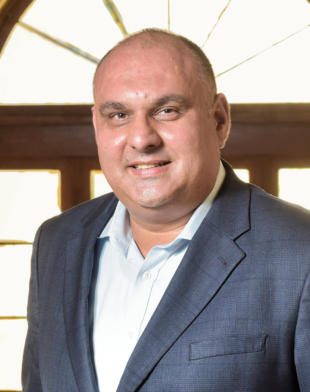
“The MCC’s museum utilizes modern technologies like augmented reality to allow visitors to experience the center’s rich history firsthand, providing a unique blend of conference and historical tourism experiences. This project comprises 15 immersive scenes throughout the center, highlighting a journey through time while maintaining focus on primary conference business,” Pierre Fenech, CEO of both the MCC and the Institute of Tourism Studies, explained.
“The MCC is the largest historical and architecturally imposing building used as a conference center in Malta. We host numerous conferences and events each year. Other conferences which are held in hotels across the island still choose our center for at least one event during their stay, mainly their gala farewell dinner to wrap up their stay in Malta with a memorable experience in an authentic Maltese historical venue.
“Our cultural offerings, highlighted by the largest theater on the island, host weekly events ranging from musicals, ballets and orchestral concerts to themed parties like the recent Carnival Ball. We are also hosting the classic ballet ‘Cinderella on Ice,’ which is a major attraction for all ballet lovers.”
While the MCC is the perfect venue for a wide variety of events and will continue to be a major draw for the global meetings, incentives, conferences and exhibitions industry, the Institute of Tourism Studies wants to attract an increasing number of international students in the years ahead. The largest institution for education in hospitality and tourism in Malta, the school has recently revamped its offerings, with a recent agreement signed with a world-renowned diving school and a partnership with the Mediterranean Screen Arts Academy to create new vocational programs.
The ITS contributes to the government’s goal of upskilling and diversifying the workforce in the tourism sector and is now keen to attract students from Japan. “We eagerly anticipate expanding our presence in Japan and welcome students seeking the European education experience. Our programs are uniquely designed to offer study opportunities not only in Malta, but also in Europe, particularly in France and Finland,” Fenech revealed.
“Foreign students can take advantage of Erasmus Plus funding when studying at our partner universities in Europe, making our offerings even more appealing. On the Mediterranean Conference Centre side, we are excited about the prospect of hosting top Japanese companies. Before the pandemic we successfully organized large conferences like the Samsung Forum from South Korea, attracting participants from around the globe. We look forward to extending a warm welcome to major Japanese companies in the future.”
www.visitmalta.com
www.mcc.com.mt
https://info.japantimes.co.jp/international-reports/pdf/20240531-GI_Malta.pdf
www.global-insight.net
